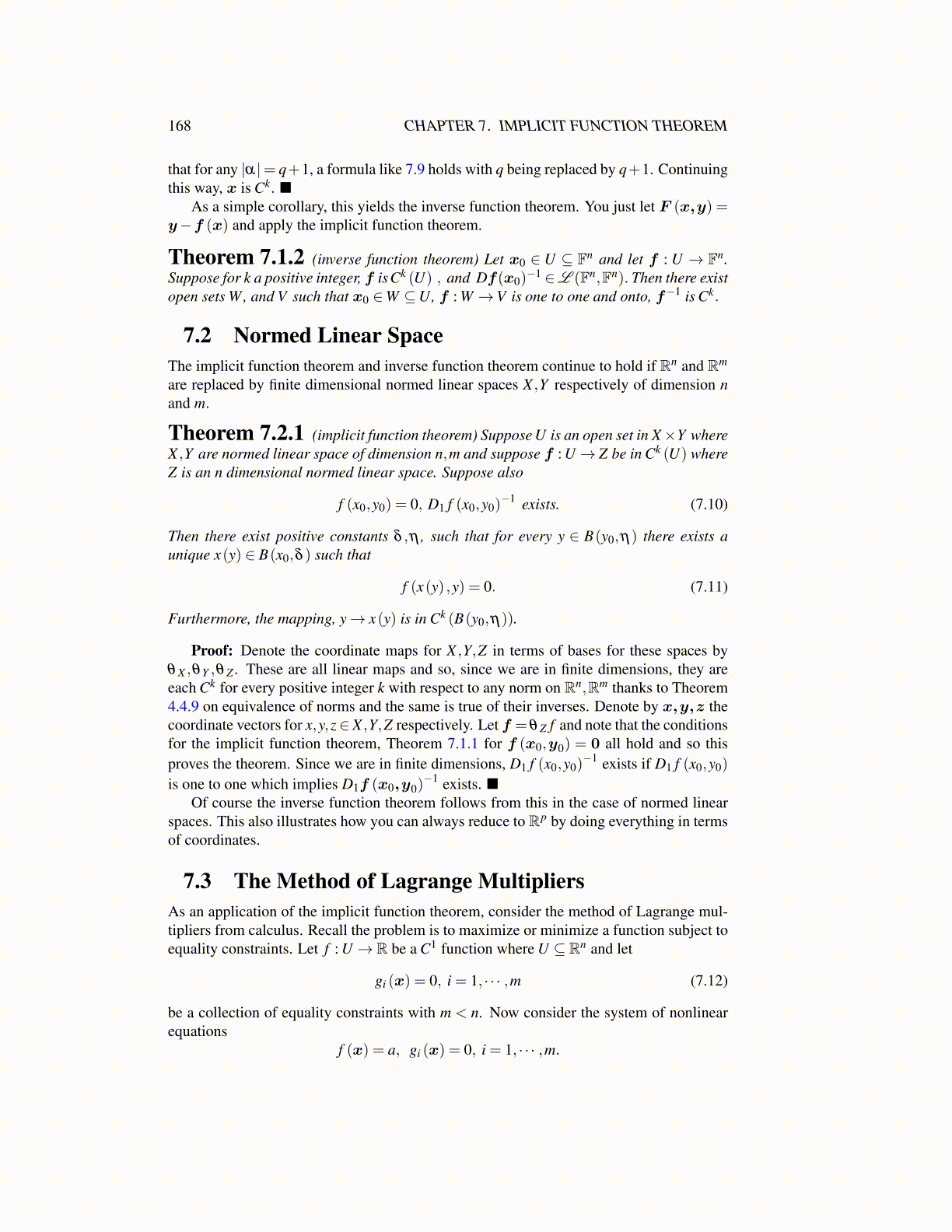
168 CHAPTER 7. IMPLICIT FUNCTION THEOREM
that for any |α|= q+1, a formula like 7.9 holds with q being replaced by q+1. Continuingthis way, x is Ck. ■
As a simple corollary, this yields the inverse function theorem. You just let F (x,y) =y−f (x) and apply the implicit function theorem.
Theorem 7.1.2 (inverse function theorem) Let x0 ∈ U ⊆ Fn and let f : U → Fn.Suppose for k a positive integer, f isCk (U) , and Df(x0)
−1 ∈L (Fn,Fn). Then there existopen sets W, and V such that x0 ∈W ⊆U, f : W →V is one to one and onto, f−1 is Ck.
7.2 Normed Linear SpaceThe implicit function theorem and inverse function theorem continue to hold if Rn and Rm
are replaced by finite dimensional normed linear spaces X ,Y respectively of dimension nand m.
Theorem 7.2.1 (implicit function theorem) Suppose U is an open set in X×Y whereX ,Y are normed linear space of dimension n,m and suppose f : U→ Z be in Ck (U) whereZ is an n dimensional normed linear space. Suppose also
f (x0,y0) = 0, D1 f (x0,y0)−1 exists. (7.10)
Then there exist positive constants δ ,η , such that for every y ∈ B(y0,η) there exists aunique x(y) ∈ B(x0,δ ) such that
f (x(y) ,y) = 0. (7.11)
Furthermore, the mapping, y→ x(y) is in Ck (B(y0,η)).
Proof: Denote the coordinate maps for X ,Y,Z in terms of bases for these spaces byθ X ,θY ,θ Z . These are all linear maps and so, since we are in finite dimensions, they areeach Ck for every positive integer k with respect to any norm on Rn,Rm thanks to Theorem4.4.9 on equivalence of norms and the same is true of their inverses. Denote by x,y,z thecoordinate vectors for x,y,z∈X ,Y,Z respectively. Let f = θ Z f and note that the conditionsfor the implicit function theorem, Theorem 7.1.1 for f (x0,y0) = 0 all hold and so thisproves the theorem. Since we are in finite dimensions, D1 f (x0,y0)
−1 exists if D1 f (x0,y0)
is one to one which implies D1f (x0,y0)−1 exists. ■
Of course the inverse function theorem follows from this in the case of normed linearspaces. This also illustrates how you can always reduce to Rp by doing everything in termsof coordinates.
7.3 The Method of Lagrange MultipliersAs an application of the implicit function theorem, consider the method of Lagrange mul-tipliers from calculus. Recall the problem is to maximize or minimize a function subject toequality constraints. Let f : U → R be a C1 function where U ⊆ Rn and let
gi (x) = 0, i = 1, · · · ,m (7.12)
be a collection of equality constraints with m < n. Now consider the system of nonlinearequations
f (x) = a, gi (x) = 0, i = 1, · · · ,m.